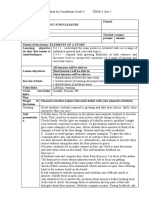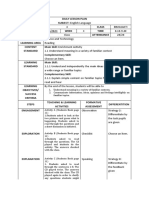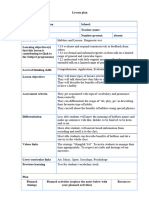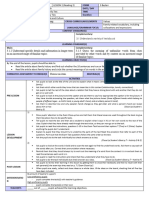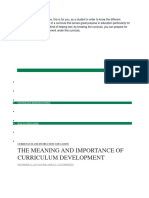Lesson 51
Lesson 51
Uploaded by
Madam Rushila RahimiCopyright:
Available Formats
Lesson 51
Lesson 51
Uploaded by
Madam Rushila RahimiOriginal Title
Copyright
Available Formats
Share this document
Did you find this document useful?
Is this content inappropriate?
Copyright:
Available Formats
Lesson 51
Lesson 51
Uploaded by
Madam Rushila RahimiCopyright:
Available Formats
WEEK/LESSON NO.
LESSON 51 (Reading 11) FORM 3 Bestari
SUBJECT English DATE / DAY
UNIT 6 TIME
TOPIC Ready, Steady, Go! Duration
THEME Health and Environment
MAIN SKILL Reading CROSS-CURRICULAR ELEMENTS Creativity and Innovation
21ST CENTURY LEARNING Choose an item. Sport related vocabulary
TECHNIQUE(S) LANGUAGE/GRAMMAR FOCUS:
CONTENT STANDARD(S)
Main: Complementary:
3.1 Understand a variety of texts by using a range of appropriate 2.1 Communicate information, ideas, opinions and feelings
reading strategies to construct meaning intelligibly on familiar topics
LEARNING STANDARD(S)
Main: Complementary:
3.1.5 Recognise with support the attitude or opinion of the 2.1.4 Explain own point of view
writer in simple longer texts on an increased range of familiar
topics
LEARNING OBJECTIVE(S)
By the end of the lesson, pupils should be able to:
Discuss whether they prefer watersports or land sports.
Read the descriptions of five teenagers looking for a sport to do and underline the reasons they give for wanting to do a sport.
Close-Up Student’s Book, p.69 - 71
FORMATIVE ASSESSMENT TECHNIQUE(S Choose an item. MATERIAL(S)
Close-Up Teacher’s Book, p.60
ACTIVITIES
Write the words Ready, Steady, Go! on the board and ask pupils when they would usually hear these words (at the
beginning of a race). Explain to pupils that this is the title of Unit 6 and ask them what they expect the unit to be about
(sport).
PRE-LESSON
Ask pupils to turn to page 69 and to look at the picture and the accompanying caption. Ask them to describe what's
happening in the picture with a partner and to discuss their reaction to it. Then, as a class, ask pupils to say how they
feel about the picture. Elicit that tortoises move extremely slowly and that the skateboard allows it to go faster.
1)
Ask pupils to look at the picture of the girl in the top right-hand corner of page 70 and ask them what she's doing
(canoeing/rafting).
Ask pupils if they think the girl needs to be fit to do such a sport. Ask them to justify their opinions.
Ask pupils to work with a partner and discuss whether they think they are fit or not and why.
Ask pupils at random to report to the class if their partner thinks they are fit or not.
Then ask pupils to continue working with their partner and discuss what water sports they have tried or if they prefer
to do sports on land.
As a class, ask pupils to tell you which water sports they have done or what other sport or sports they prefer to do.
LESSON (Student’s Book p.70– Activity A)
DEVELOPMENT 2)
Ask pupils to read the instructions.
Give pupils about five minutes to write down why they think people do sports.
Ask pupils to work with a partner and to take it in turns to say the reasons they have come up with.
Check answers as a class. (Student’s Book p.70 – Activity B)
3)
Ask pupils to read the instructions and check that they understand what they have to do.
Ask pupils to read the descriptions 1-5 in the Exam Task and underline any reasons they give for wanting to do sport.
Ask pupils to do the task individually but check the answers as a class. (Student’s Book p.70 – Activity C)
Ask pupils to identify with their talk partner(s) at least one new word or expression that they have learned in relation
POST-LESSON to the lesson topic.
When pupils are ready, collect and share words/expressions as a whole class.
By amount of teacher’s support:
Low-proficiency pupils
DIFFERENTIATIO
- pupils complete the tasks(s) with teacher’s guidance
N High-proficiency pupils
- pupils complete the tasks(s) on their own
TEACHER’S _____ out of ______ pupils achieved the learning objectives.
REFLECTION _____ pupils were given remedial treatment.
You might also like
- First Conditional Lesson PlanDocument4 pagesFirst Conditional Lesson Plansveta100% (2)
- List of Awards - Kinder To SHSDocument5 pagesList of Awards - Kinder To SHSApril Lyn Sarmiento94% (16)
- Subject Link 7 - TGDocument73 pagesSubject Link 7 - TGDin50% (2)
- Unit 6 Time OutDocument14 pagesUnit 6 Time OutAziah AzizNo ratings yet
- Subject Link 3 - Teacher's GuideDocument59 pagesSubject Link 3 - Teacher's GuideYasser Mohamed100% (1)
- Subject Link Starter 1 TGDocument61 pagesSubject Link Starter 1 TGruslan11No ratings yet
- 21st Century Literature Lesson Exemplar IDocument2 pages21st Century Literature Lesson Exemplar Immv VILLA100% (3)
- Classroom Management PortfolioDocument25 pagesClassroom Management Portfolioapi-506228865100% (1)
- Week 6Document8 pagesWeek 6MUHAMMAD ASYRAF BIN HAMDAN KPM-GuruNo ratings yet
- Unit 6 Ready, Steady, Go!Document11 pagesUnit 6 Ready, Steady, Go!zzarirahNo ratings yet
- Lesson 58Document1 pageLesson 58Madam Rushila RahimiNo ratings yet
- Unit 7 Extreme SituationsDocument10 pagesUnit 7 Extreme SituationsamirahaisyahNo ratings yet
- Lesson 56Document2 pagesLesson 56AliisaAkamaiNo ratings yet
- Lesson 107Document2 pagesLesson 107Madam Rushila RahimiNo ratings yet
- Lesson 77Document1 pageLesson 77Khairul HafiziNo ratings yet
- Latest Form 3 Lesson Plan (Cefr/kssm English Daily Lesson Plan) RPH Bahasa Inggeris Sekolah Menengah Tingkatan 3 TerkiniDocument2 pagesLatest Form 3 Lesson Plan (Cefr/kssm English Daily Lesson Plan) RPH Bahasa Inggeris Sekolah Menengah Tingkatan 3 Terkinierfolg.prominence100% (1)
- Week 25Document24 pagesWeek 25NURBAHIYYAH SYAZWANI BINTI ZAINURIN KPM-GuruNo ratings yet
- Unit 5 GlobetrottingDocument14 pagesUnit 5 GlobetrottingSainah Manigoth100% (1)
- Lesson 134 TS25Document3 pagesLesson 134 TS25ShAh RuDiNo ratings yet
- Lesson 72Document2 pagesLesson 72Madam Rushila RahimiNo ratings yet
- Think 9 UnitDocument19 pagesThink 9 UnitРаушан АскарNo ratings yet
- Children's Games 1: All Learners Will Be Able ToDocument43 pagesChildren's Games 1: All Learners Will Be Able ToMaykl JordanNo ratings yet
- RPH Form 4 WEEK 2Document4 pagesRPH Form 4 WEEK 2Matthew MantraNo ratings yet
- Lesson 17Document1 pageLesson 17syamimisdNo ratings yet
- English Download Student's Book p64Document1 pageEnglish Download Student's Book p64Siti Athirah100% (1)
- Lesson 105Document2 pagesLesson 105Hafiz AbdullahNo ratings yet
- Subject Link 4 - TGDocument67 pagesSubject Link 4 - TGsolsol0125No ratings yet
- 7кл Кмж ExcellDocument205 pages7кл Кмж ExcellzbekkyzyNo ratings yet
- Unit 4 Special RelationshipDocument10 pagesUnit 4 Special RelationshipAleh TiongNo ratings yet
- 1.6.22 (Wednesday)Document4 pages1.6.22 (Wednesday)Siti AthirahNo ratings yet
- 20.6.22 (Mon)Document4 pages20.6.22 (Mon)Siti AthirahNo ratings yet
- ExcerptDocument10 pagesExcerptdr.mohamed nabilNo ratings yet
- Lesson 79Document1 pageLesson 79Madam Rushila RahimiNo ratings yet
- Lesson 6Document1 pageLesson 6g-25140090No ratings yet
- Lesson 65Document1 pageLesson 65Madam Rushila RahimiNo ratings yet
- Is Used To Refer To Crime Fiction.) .: English DownloadDocument1 pageIs Used To Refer To Crime Fiction.) .: English DownloadSiti AthirahNo ratings yet
- Lesson 26Document1 pageLesson 26farah famiNo ratings yet
- 4 grade Smiles 1-term ҚМЖDocument34 pages4 grade Smiles 1-term ҚМЖЖулдызNo ratings yet
- Latest Form 5 Lesson Plan (Cefr/kssm English Daily Lesson Plan) RPH Bahasa Inggeris Sekolah Menengah Tingkatan 5 TerkiniDocument2 pagesLatest Form 5 Lesson Plan (Cefr/kssm English Daily Lesson Plan) RPH Bahasa Inggeris Sekolah Menengah Tingkatan 5 Terkinierfolg.prominenceNo ratings yet
- Minggu 11Document42 pagesMinggu 11BHAVANI A/P RAMASAMY RAMANATHAN MoeNo ratings yet
- Lesson 4 English Form 3 Close UpDocument1 pageLesson 4 English Form 3 Close Upg-28512796No ratings yet
- w10 Bi 4utm, 4upm, 4 UkmDocument10 pagesw10 Bi 4utm, 4upm, 4 UkmNur Hafiza Hj BakriNo ratings yet
- LESSON 3 TTDocument2 pagesLESSON 3 TTZANARIAH BINTI JAAPAR MoeNo ratings yet
- Minggu 4 - RPH Minggu 4Document7 pagesMinggu 4 - RPH Minggu 4faridooiNo ratings yet
- LP Year 3Document156 pagesLP Year 3RUSDYNo ratings yet
- Lesson 50Document2 pagesLesson 50AliisaAkamaiNo ratings yet
- Weather and SeasonsDocument10 pagesWeather and Seasonsapi-351959830No ratings yet
- p84 Activity 1 & 2) : Teachers' HandoutDocument1 pagep84 Activity 1 & 2) : Teachers' HandoutFaryz Tontok Tinan 오빠No ratings yet
- Minggu 11Document41 pagesMinggu 11BHAVANI A/P RAMASAMY RAMANATHAN MoeNo ratings yet
- p84 Activity 1 & 2) : Teachers' HandoutDocument1 pagep84 Activity 1 & 2) : Teachers' HandoutFaryz Tontok Tinan 오빠No ratings yet
- 8.11, Tue f5Document1 page8.11, Tue f5Siti AthirahNo ratings yet
- Unit 1 Let - S ChatDocument15 pagesUnit 1 Let - S ChatAsyrafHamdanNo ratings yet
- Environmental Problems Lesson PlanDocument3 pagesEnvironmental Problems Lesson PlanMarla PeppersNo ratings yet
- Opt b1 Clil Units3-4 TNDocument1 pageOpt b1 Clil Units3-4 TNAna Gabriela Cortès BarreraNo ratings yet
- Warm UpDocument51 pagesWarm UpAibek TashkenbaevNo ratings yet
- Unit 5 GlobetrottingDocument16 pagesUnit 5 GlobetrottingyayaNo ratings yet
- ExcerptDocument14 pagesExcerptGameply frag SabataNo ratings yet
- Lesson 2 English Form 3 Close UpDocument2 pagesLesson 2 English Form 3 Close Upg-28512796No ratings yet
- ҚМЖ 4кл - 130бDocument86 pagesҚМЖ 4кл - 130бМадияр Асарбаев100% (1)
- Lesson 93Document1 pageLesson 93Madam Rushila RahimiNo ratings yet
- Teacher Book B1Document2 pagesTeacher Book B1anhhoa1210No ratings yet
- Unit 12 ReadingDocument2 pagesUnit 12 ReadingMOHAMMAD LUQMAN DINIE BIN SHAARI KPM-GuruNo ratings yet
- Teaching Speaking Commentating: Lesson PlanDocument8 pagesTeaching Speaking Commentating: Lesson PlanAhmadNo ratings yet
- Lesson 100Document1 pageLesson 100Madam Rushila RahimiNo ratings yet
- Lesson 107Document2 pagesLesson 107Madam Rushila RahimiNo ratings yet
- Lesson 79Document1 pageLesson 79Madam Rushila RahimiNo ratings yet
- Lesson 93Document1 pageLesson 93Madam Rushila RahimiNo ratings yet
- Lesson 72Document2 pagesLesson 72Madam Rushila RahimiNo ratings yet
- Lesson 65Document1 pageLesson 65Madam Rushila RahimiNo ratings yet
- Detailed Lesson Plan in ScienceDocument4 pagesDetailed Lesson Plan in ScienceWilliam Michael Marikit Santia Jr.No ratings yet
- Per g21 Pub 2083 Touchstone AssessmentQPHTMLMode1 2083O18231 2083O18231S9D54322 15473559700536598 UP18305700 - 2083O18231S9D54322E3.html#Document43 pagesPer g21 Pub 2083 Touchstone AssessmentQPHTMLMode1 2083O18231 2083O18231S9D54322 15473559700536598 UP18305700 - 2083O18231S9D54322E3.html#Maruti NandanNo ratings yet
- CurriculumDocument30 pagesCurriculumnelsonNo ratings yet
- Grade 10 EnglishDocument3 pagesGrade 10 EnglishJesary Marc ArnosaNo ratings yet
- Values education-CUF-Lesson-Plan-InterventionDocument2 pagesValues education-CUF-Lesson-Plan-InterventionAnna Marie Carmen CervantesNo ratings yet
- Mathematics Lesson Plan: Grade 4 TERM 4: October - DecemberDocument5 pagesMathematics Lesson Plan: Grade 4 TERM 4: October - DecemberBrittany Van Der Westhuizen0% (1)
- Faculty Evaluation CalculatorDocument2 pagesFaculty Evaluation Calculatorhentaiwtkouhai177013No ratings yet
- ORIENTATIONDocument16 pagesORIENTATIONCông Nguyễn ThànhNo ratings yet
- Academic Self-Efficacy in Education: Myint Swe Khine Tine Nielsen EditorsDocument257 pagesAcademic Self-Efficacy in Education: Myint Swe Khine Tine Nielsen Editorskhangnb25No ratings yet
- DBM-CSC Form No. 1 Position Description FormDocument26 pagesDBM-CSC Form No. 1 Position Description FormMikolie Lawi Maunting100% (1)
- Catch Up Friday Class ProgramDocument3 pagesCatch Up Friday Class ProgramCathlyn MerinoNo ratings yet
- Leadership AwardDocument4 pagesLeadership AwardJhonel Mogueis Dela CruzNo ratings yet
- Objective 12Document8 pagesObjective 12Cedrick Estrada NaragNo ratings yet
- February 21, 2020: Intermolecular ForcesDocument3 pagesFebruary 21, 2020: Intermolecular ForcesGerald Jhim de UbaldoNo ratings yet
- Co2 - Q4 Lesson Exemplar Tools and Equipment in Preparing DessertDocument12 pagesCo2 - Q4 Lesson Exemplar Tools and Equipment in Preparing DessertGinaNo ratings yet
- Sample Notebook CoverDocument17 pagesSample Notebook CoverDonabelEscotaEspañoNo ratings yet
- Science Lesson 1 1Document3 pagesScience Lesson 1 1api-636459501No ratings yet
- Research Paper Template-2Document7 pagesResearch Paper Template-2api-516964593No ratings yet
- Daily Lesson Plan: Learning Area: Grade Level: DurationDocument3 pagesDaily Lesson Plan: Learning Area: Grade Level: DurationCyril DofelizNo ratings yet
- DissDocument6 pagesDissBemBemNo ratings yet
- Field Experience Journal EntriesDocument3 pagesField Experience Journal Entriesapi-2518075480% (1)
- CHAPTER 6 Learning Module Educ. 10 Revised 2021 2022Document9 pagesCHAPTER 6 Learning Module Educ. 10 Revised 2021 2022Jenny C. GalonoNo ratings yet
- Math Mge Lesson PlanDocument7 pagesMath Mge Lesson Planapi-444425700No ratings yet
- Red Clay Conrad Choice ProceedureDocument1 pageRed Clay Conrad Choice ProceedureJohn AllisonNo ratings yet
- Darmasiswa - Indonesian Scholarship ProgramDocument2 pagesDarmasiswa - Indonesian Scholarship ProgramKhan AliNo ratings yet
- Home-School AgreementDocument2 pagesHome-School Agreementisleworthsyon100% (1)




















